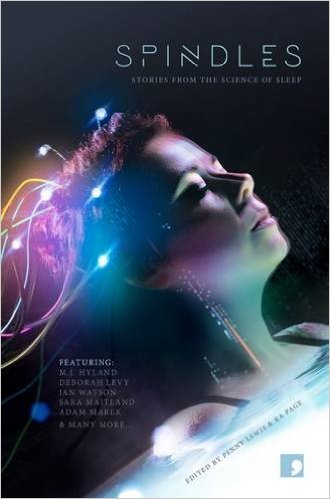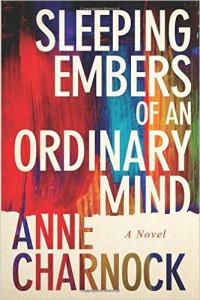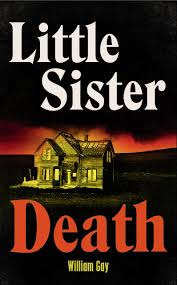 William Gay died in 2012. Little Sister Death was found with his papers, only partially typed up but still ostensibly complete in longhand draft. A group of Gay’s close friends and fellow writers put everything together in the right order. The novel was published late last year. I wrote about it as I went along, breaking off from my reading to record my thoughts. The numbered sections below do not tie in precisely to the named parts of the novel, they are my own arbitrary divisions. Still, they make a kind of sense.
William Gay died in 2012. Little Sister Death was found with his papers, only partially typed up but still ostensibly complete in longhand draft. A group of Gay’s close friends and fellow writers put everything together in the right order. The novel was published late last year. I wrote about it as I went along, breaking off from my reading to record my thoughts. The numbered sections below do not tie in precisely to the named parts of the novel, they are my own arbitrary divisions. Still, they make a kind of sense.
ONE
He had stopped wondering where he was. He knew from the crying of the whippoorwills that night had fallen. He knew that the ground was frozen, for he could hear the iron rims of the wagon wheels turning against earth frozen in icy whorls. He knew that he’d been in the woods; a branch had rapped him hard and cut his face, a trickle of blood had frozen, crusted like a scarlet slash from a solitary fingernail. (LSD p 6)
Little Sister Death opens in Tennessee, in the year 1785. Dr Mayfield has been kidnapped off the street in front of his house, taken by a man with muttonchop whiskers and his black servant to a log house in the middle of nowhere where he has been brought, as the black man tells him, to treat ‘sick people’. He’s never seen either of them before. He has no idea why he has been chosen, or what for. The man with muttonchop whiskers has some sort of mouth injury that has rendered him unable to eat or to speak clearly, though the doctor soon discovers that this is not the reason he has been taken.
I found the opening of this novel utterly compelling. There’s a sense of malice here – of trouble brewing – that makes you feel tense even as you’re reading. When the climax of this chapter comes – you’ll know when that is, believe me – it’s staggeringly horrifying, all the more so because although you’ve been waiting for something like this to happen, it still seems to erupt out of nowhere, just when you’ve started to think the doctor may be all right after all.
Gay’s writing is clear, direct, deceptively simple. Not a single word wasted and proving in spades that if you’re as good a writer as Gay you can do anything with straight narrative fiction – deliver any surprises and shocks you want.
TWO
‘He was watching the home place and he was pondering the nature of its evil, not wondering if there was evil indeed there but knowing it with an absolute certainty that he applied to very few things. What triggered it? he wondered. How did it work, and how did it ever come to be there? Something old and evil had happened here, so evil that came after was just echoes, just spreading ripples in the water so intense that Beale and his family had ultimately abandoned the house and rebuilt in the place he was now moving into. Though that didn’t help, did it, Old Jake? Binder thought. Whatever it was just walked across the ridge and knocked at your door. (p 41)
It’s now the 1980s. David Binder, a writer, has moved with his wife Corrie and young daughter Stephie from Chicago to Tennessee, and into the ‘Beale house’. Binder has acquired the house on the six-month lease. He intends to write a book about some notorious events there, a book that will be solidly commercial and make him some money. Already after just a couple of days on the property he seems too involved, already we are beginning to get the sense that this will not end well for him. Binder seems kind of selfish. He goes after what he wants and damn the consequences. Corrie doesn’t seem to have much choice in anything. David doesn’t ever really confide in her. He thinks of her as ‘high strung’, and therefore not to be told certain things. The accidental killing of a rabbit is a bad omen, and reminiscent of the hare that dies under the plough at the beginning of John Fowles’s Daniel Martin.
This section initially lacks the magisterial gothic grandeur of the opening but this is not necessarily a bad thing as it creates an interesting duality between past and present. The present seems at first lighter, more disposable, but that texture gradually changes as we approach the Beale house itself. Seeing Binder watching the old property we get an echo of the feelings we experienced during the first chapter.
This is concise, intensely readable prose. It reminds me a little of some of the very best of Stephen King’s writing – the early chapters of ‘Salem’s Lot, for example – but entirely lacks that writer’s tendency to over-pad. There is a languid heat to the prose – nothing is hurried, not even the tension. One longs to hear this book read aloud in Gay’s southern accent.
THREE
Back to 1933. Owen Swaw, a sharecropper, is offered the tenancy of the Beale place in return for raising and harvesting the corn crop. He’s unexpectedly reluctant – there’s something about the place he doesn’t like – but his wife Lorene insists. They have four growing daughters and no space. The Beale place is enormous. The girls love it. Swaw begins to see things – odd things, odd people, a black dog – and his temper seems addled. Nothing pleases him – and then he is seduced by a ghost:
That’s my little sister yonder, the preacher said, pointing, and Swaw turned, so caught up in the snake that he was aware of the girl’s presence for the first time. She stood in the corner facing an isinglass window of the tent watching him and slowly turned. Swaw suddenly felt chilled, aware of the cold layers of wet clothing against his skin, and for a dizzy second he thought he was going to faint, for the world darkened and everything looked vague and far away. The preacher was still talking, but sounds had diminished and Swaw couldn’t understand him. (p 89)
This whole section is dry and airless, like the oppressive summer weather that pervades it. We sense the approach of disaster – the disaster we have had described to us in Binder’s first section – but our foreknowledge of what is to happen does not diminish it.
FOUR
He was obscurely happy, drawing comfort from sourceless and insignificant things he always took for granted: the work he was doing, the soft worn feel of the faded jeans he was wearing, the sounds of the night beyond the walls, the feeling of the peace they engendered, the chaos of the world walled out.
They ate the ice cream on the stone doorsteps, touched by a sense of closeness without having to voice it. It had been a long day, an unhurried purposeless day Binder had stolen from the book, like a day he had managed to hoard from his childhood, squander when the mood suited him.
Later he would remember it as the last outpost of normalcy, a waystation to darker provinces. (p 111)
Things are weirding up on the Beale land. The haunting is taking hold. Binder is gripped – and not just by the book he is writing. It’s his family you fear for. The atmosphere is horrifying, a kind of polluted stillness. The plot is strongly reminiscent of the movie Sinister, though with none of that film’s determination to ruin itself through horror cliché.
Following the latest from Binder we have an extract from an earlier book on the Beale haunting, referred to frequently by Binder during the course of his research. Now we begin to learn more about the origins of the haunting, and the way these events mirrored themselves compulsively in what happened to Swaw.
FIVE
Sunday afternoon was more of the same, hot and clear and a mile long. The steady clack clack clack of the typewriter ceasing only when he paused to light a cigarette, make coffee, go to the bathroom. She was counting the days till Labor Day. (p 138)
As Binder becomes ever more deeply possessed by the rhythms and secret murmurings of the haunted dell, Corrie remembers other occasions when her husband was needlessly, destructively selfish. Binder stops watching TV and especially the news, anything that will remind him of the world beyond Beale Station, which comes to seem increasingly dreamlike, increasingly irrelevant.
On Labor Day weekend, Corrie’s sister Ruthie and her odious husband Vern come to visit. Binder can’t stand Vern, and feels increasingly annoyed with Corrie for not disliking him more. When they go to a local dance to celebrate the holiday, Vern is in his element. Binder is relieved to be out of the house for a bit. Then he sees someone in the crowd:
There was an eerie familiarity about her, as if she were a creation from his fantasies, from his dreams – or worse, he suddenly thought, fearing madness, from the book he was writing. The face was placid and smooth, seemed touched with the remnants of a lost, corrupt sweetness, a doomed innocence, and he knew irrevocably that he wanted her more than he had ever wanted anything. The book, Corrie, life itself. (p 176)
And Vern? I love this:
In the stark clarity of the moonlight his face looked vacuous and haggard, less like a bored housewife’s dream and more like a man drifting against his will aimlessly into middle age. (p 181)
Throughout this novel, Gay’s writing is strongest when he’s describing the gaunt and vaguely threatening beauty of the Tennessee landscape. The landscape is not to blame for the tragedy exactly, but it is complicit, it grants it asylum.
QUEEN OF THE HAUNTED DELL
We leave Binder hanging, arguing with Corrie in a hospital car park. Suddenly we’re in the present, and William Gay is recounting the true history of the Bell Witch haunting, on which Little Sister Death is based. We meet Chris Kirby, who now owns the Bell farm and who is obsessed with the story. The Blair Witch Project is referenced. Gay tells us about his own brush with the ghost. It’s a surprising and intriguing breach of the fourth wall and not surprisingly I find I like this aspect of the novel a lot. It makes the book feel strange, telescoped back into itself. What are we to make of it? The fact that it was published posthumously, reconstructed from Gay’s own longhand notes and typescript, makes us ask ourselves if it was finished, even.
In a sense, there are three books here: the grim southern gothic of the opening chapters, pulsing with life and cruel mysteries, the initially languid, steadily escalating horror of the Binder chapters, and finally the metafictional idea of a writer collating research material for that very novel. I like the resulting composite, a lot, though there is a part of me that still yearns for the novel that might have been, the novel we glimpse in that opening chapter, the kidnapped doctor on his fatal journey, the terrible act we see perpetrated in a remote farmhouse.
The problem with affect horror is its fatalism, the way its entire energy is directed towards generating an atmosphere of dread rather than pursuing the active forward momentum of a story. The opening sequence of Little Sister Death forms one of the most gripping and beauteously written passages of horror fiction I’ve read in a long time. Most of the rest of the book lacks that tension, because the law of affect horror tells us that David Binder is doomed from the beginning. There is nothing for us to do but sit around waiting for him to go crazy.
For me at least, the irruption of the metafictional into this scenario goes a long way towards mitigating the deadening effect of affect horror. It throws everything into question, even Binder’s eventual fate. If Gay had continued with Binder’s story we know exactly how it would have played out – he showed us already, with Owen Swaw. As things stand at the end, who knows? Perhaps Binder got lucky and got out. I know I like to think so.
A wonderfully engrossing read, with some enthralling writing, this is exactly the kind of novel we should be seeing on horror fiction awards shortlists, but rarely do. Little Sister Death is a valuable addition to the canon. Although its compact length is a refreshing and welcome change, I nonetheless find myself wishing this book had been longer. I miss the Binders.
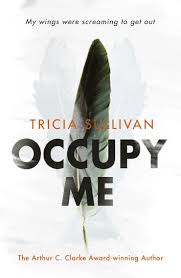 Today I’d like to say a few words about two brand new science fiction novels that I was lucky enough to have the chance to read in manuscript. The first is Occupy Me, by Tricia Sullivan. If I were to tell you that Occupy Me is the story of an angel discovering her true destiny, that would probably give you an extremely skewed idea of what this novel is actually like. If I were to tell you that Occupy Me is the story of a quantum being discovering the gateway to another universe, that might give you a better sense of the textures and themes you’ll find yourself experiencing if you pick up this book. Both statements would be true. Neither gives the whole picture.
Today I’d like to say a few words about two brand new science fiction novels that I was lucky enough to have the chance to read in manuscript. The first is Occupy Me, by Tricia Sullivan. If I were to tell you that Occupy Me is the story of an angel discovering her true destiny, that would probably give you an extremely skewed idea of what this novel is actually like. If I were to tell you that Occupy Me is the story of a quantum being discovering the gateway to another universe, that might give you a better sense of the textures and themes you’ll find yourself experiencing if you pick up this book. Both statements would be true. Neither gives the whole picture.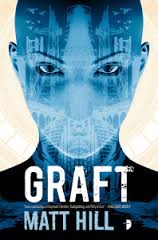 working from a place of deep compassion. Compassionate would not be the first word that comes to mind when describing the various protagonists of Matt Hill’s thrilling second novel Graft – the book opens with a particularly brutal punishment shooting – but travel the road with them a little further and you might be surprised. What Graft also has in common with Occupy Me is an interest in quantum dimensions and parallel futures – according to Hill as to Sullivan, these can be very dangerous places to wind up in.
working from a place of deep compassion. Compassionate would not be the first word that comes to mind when describing the various protagonists of Matt Hill’s thrilling second novel Graft – the book opens with a particularly brutal punishment shooting – but travel the road with them a little further and you might be surprised. What Graft also has in common with Occupy Me is an interest in quantum dimensions and parallel futures – according to Hill as to Sullivan, these can be very dangerous places to wind up in.
